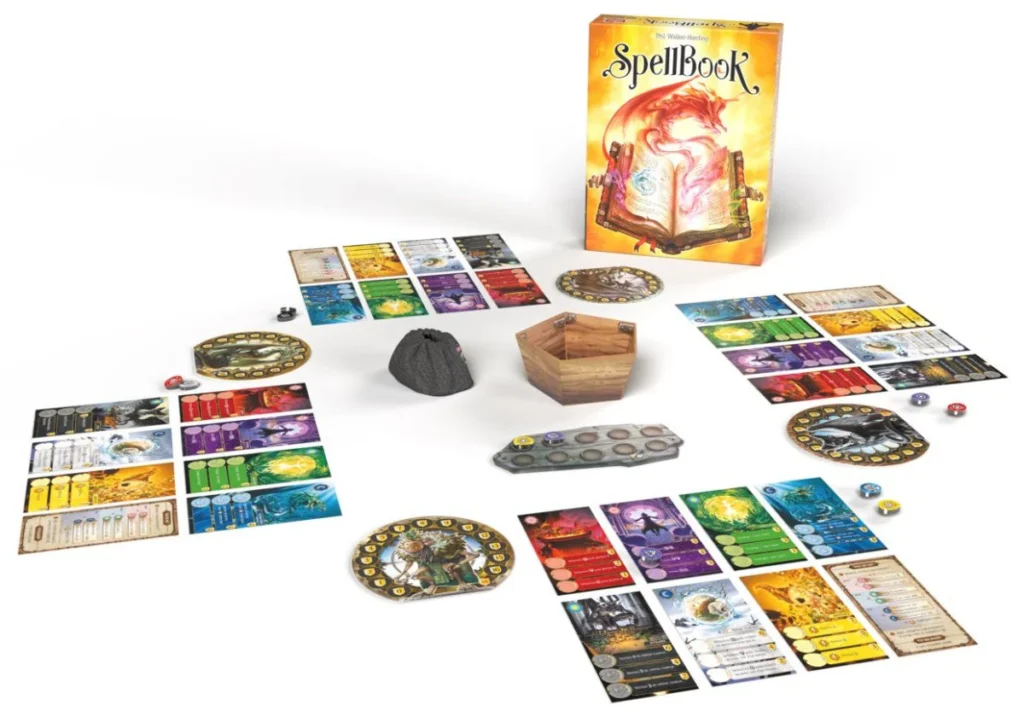Getting together with friends or colleagues over a board or card game is a fun way to hang out and unwind. Games are good for post conference networking and can be a good way to decompress from the day’s sessions. However, if you don’t know how to play a game, using up more brain power is likely the last thing you want to do after a long day of work or conferencing. Luckily, Spellbook aims to change all that.
Learn in just a few minutes
Thanks to VR Distribution, I had the chance to sit down with Phil Walker-Harding, the creator of the board game Spellbook. Walker-Harding enjoys video games and attended film school with aspirations of becoming a director, but eventually found his niche in the board games industry. He’s an Australian game designer, and best known for the board game Sushi Go!.
Walker-Harding was playing lots of mass market games growing up, and played a lot of board games. Many of us would know the feeling of sitting down to play a board or card game and realising several rounds in, that you still don’t know what is going on. Walker-Harding wanted to change all this with his games. Sushi Go! for example says Walker-Harding “can be learned by watching one round”. He wanted to do the same with Spellbook saying “[he] wants a game that can be taught and learned in just a few minutes”. No more sitting around, watching rounds until you understand what’s going on, or idly playing cards because you don’t know exactly what you’re doing.

Game mechanics of Spellbook
Whilst creating this game, Walker-Harding “thought about a game mechanism that [he] really liked”. In this case it was spells and collections. “Wouldn’t it be cool to play a game where when you play a set, you get a special kind of power” explains Walker-Harding. Lots of spells were invented for Spellbook as the name implies, and Walker-Harding wanted to “aim for a wide audience” with this board game. Originally designed as cards, Spellbook now has tokens for players. Each player is a wizard and the game can be played with one to four players. Yes, that’s right, you can play this game solo. If you need a time out from a conference or tech talk, pull out Spellbinder for a few minutes of physical touch play.
The board game comes with 84 spell cards, 105 tokens, four familiar boards, four player aid cards, a token for the first player, a discard box, a rulebook, and pouch to store all your tokens. The physical size of the game is less than Settlers of CATAN, but will require more luggage space than Exploding Kittens if you’re planning on taking this to a friend’s house or your next conference.


What is Spellbook?
In this game, each player has a familiar and will possess a grimoire. The aim of the game is to collect Materia, master spells and feed your familiar. The game ends when one player either completes their grimoire, or fully feeds their familiar. Then points are calculated and the player with the most points wins. Inspired by games such as Rummy and Magic: The Gathering, this fun game is designed for games to take between 30 to 34 minutes. This provides enough time to unwind without needing to invest your entire evening into one game.


Setup Spellbook
Spellbook has a fairly straight forward and quick setup process. Place the small grey game board on a table or other surface to play on. Each player takes their player familiar board which will track progress throughout the game. Individual players should also take their starting aid card, as well as seven spells. Every player has the same seven spells so you don’t need to learn to use specific spells every game. Place the full token bag on the table as well as the discard box.


Determine the first player by dice roll or other method. That player then takes the First Player Token, and players take it in turns clockwise.
Playing Spellbook
Since everyone has the same seven spells, you might think there isn’t much strategy to Spellbook. It was super easy to grasp the game concept in one turn, and even come up with some strategies; either storing materia on the familiar board, or aiming to learn all seven spells. The game progresses taking it in turns. On each turn, you’ll move through morning, midday, or evening. Start by either taking one materia from the game board in the middle, drawing two materia from the blind bag, or using a morning action card.


It then moves to midday, where you can store one materia on your familiar board, or play a midday action card. Finally, it’s evening where you can choose to learn a spell (if you have enough materia), or play an evening action card. If the game board in the middle (also called the altar) is full, you can refill it. Spellbook is a super self explanatory and fun to play with others, or solo. I certainly enjoyed playing more with others, but solo is good for practicing some new strategies.


Board and card games have grown in popularity
Probably a by-product of the COVID-19 pandemic, board and card games have become more popular. Games like Settlers of CATAN and Exploding Kittens are now available in mainstream stores such as Target, Kmart, and Big W. Spellbook is available from Big W and specialty games stores starting at $49.95 AUD. Have you jump on the board games bandwagon? What are you playing?




